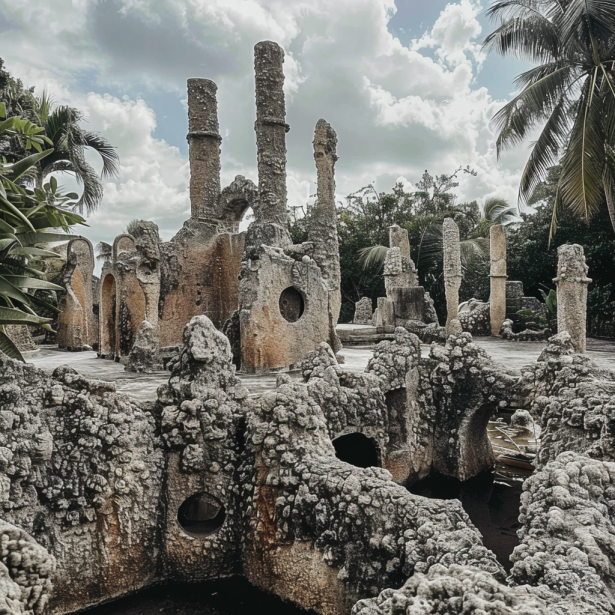Introduction
The Coral Castle, located in Homestead, Florida, is an extraordinary stone structure that continues to baffle scientists and engineers. Built by Latvian-American eccentric Edward Leedskalnin between 1923 and 1951, the castle is composed of over 1,100 tons of coral rock. Leedskalnin, who stood just over five feet tall and weighed around 100 pounds, claimed to have discovered the secrets of the ancient pyramids and used these mysterious techniques to move and carve the massive stones single-handedly. Despite numerous theories, the precise methods he employed remain unknown, adding to the enigma of the Coral Castle.
Edward Leedskalnin: The Man Behind the Castle
Background and Inspiration
Edward Leedskalnin was born in Latvia in 1887 and immigrated to the United States in the early 1920s. Heartbroken after his fiancée called off their wedding the day before the ceremony, Leedskalnin dedicated his life to building the Coral Castle as a tribute to his lost love. He began construction in Florida City in 1923, later relocating the entire structure to Homestead in 1936.
Construction Techniques
Leedskalnin worked alone and primarily at night, maintaining a shroud of secrecy around his methods. He claimed to have discovered the secrets of magnetism and leverage, which allowed him to manipulate the massive stones with ease. Witnesses occasionally reported seeing him using simple tools, such as pulleys and tripods, but no one ever observed his full process.
The Structure of the Coral Castle
Design and Features
The Coral Castle complex includes numerous impressive features, such as:
- The Obelisk: A 28-ton stone tower that stands as one of the largest single pieces in the castle.
- The Sundial: A precise timekeeping device made from stone.
- The Polaris Telescope: A stone telescope aligned with the North Star.
- The Stone Gate: A nine-ton revolving gate that can be moved with minimal effort, demonstrating Leedskalnin’s engineering prowess.
Material and Scale
The castle is built from oolite limestone, often referred to as coral rock. The stones are quarried on-site and shaped into massive blocks, some weighing up to 30 tons. The precision with which these blocks are cut and assembled continues to amaze modern engineers.
Theories and Speculations
Magnetic Fields and Leverage
One popular theory suggests that Leedskalnin understood and utilized magnetic fields in conjunction with leverage to move and position the stones. Leedskalnin’s writings, including a booklet titled “Magnetic Current,” discuss his unconventional views on magnetism, leading some to believe he applied these principles in his construction techniques.
Ancient Egyptian Techniques
Leedskalnin himself hinted that he had discovered the techniques used by the ancient Egyptians to build the pyramids. Some researchers speculate that he might have used a combination of simple machines and a deep understanding of physics to achieve his feats, similar to the methods hypothesized for pyramid construction.
Other Speculative Theories
Various speculative theories, ranging from extraterrestrial assistance to secret anti-gravity technologies, have been proposed to explain the construction of the Coral Castle. While these theories capture the imagination, they remain unsupported by concrete evidence.
Scientific Investigations and Modern Perspectives
Engineering Analysis
Modern engineers have studied the Coral Castle to understand how Leedskalnin could have moved the massive stones. While they acknowledge his impressive skills in leverage and mechanical advantage, the exact techniques remain speculative due to the lack of direct observation and detailed records.
Magnetic Studies
Some researchers have conducted studies on the magnetic properties of the stones and the site itself, exploring the possibility that Leedskalnin’s understanding of magnetism played a role in the construction. However, these studies have yet to provide definitive explanations.
Cultural Impact and Legacy
Tourist Attraction
Today, the Coral Castle is a popular tourist attraction, drawing visitors from around the world. It serves as both a monument to Leedskalnin’s devotion and an enduring mystery that continues to intrigue and inspire.
In Popular Culture
The Coral Castle has been featured in numerous books, documentaries, and television shows, cementing its place in popular culture as a modern wonder and a testament to human ingenuity and determination.
Conclusion
The Coral Castle remains one of the most enigmatic structures in the world, a testament to Edward Leedskalnin’s remarkable ingenuity and dedication. Despite numerous theories and scientific investigations, the precise methods he used to construct this massive stone complex remain unknown. As the Coral Castle continues to captivate visitors and researchers alike, it stands as a lasting symbol of mystery and the potential of human achievement.
FAQs
Who built the Coral Castle?
The Coral Castle was built by Latvian-American Edward Leedskalnin between 1923 and 1951.
What is the Coral Castle made of?
The Coral Castle is constructed from over 1,100 tons of oolite limestone, also known as coral rock.
How did Edward Leedskalnin move the massive stones?
Leedskalnin claimed to have discovered the secrets of magnetism and leverage, but the exact methods he used remain unknown.
What are some features of the Coral Castle?
Notable features include the Obelisk, the Sundial, the Polaris Telescope, and the Stone Gate.
What theories exist about the construction of the Coral Castle?
Theories range from the use of magnetic fields and leverage to ancient Egyptian techniques and speculative ideas like extraterrestrial assistance.
Is the Coral Castle a popular tourist attraction?
Yes, the Coral Castle is a popular tourist destination, attracting visitors from around the world who are fascinated by its mystery and engineering marvels.

